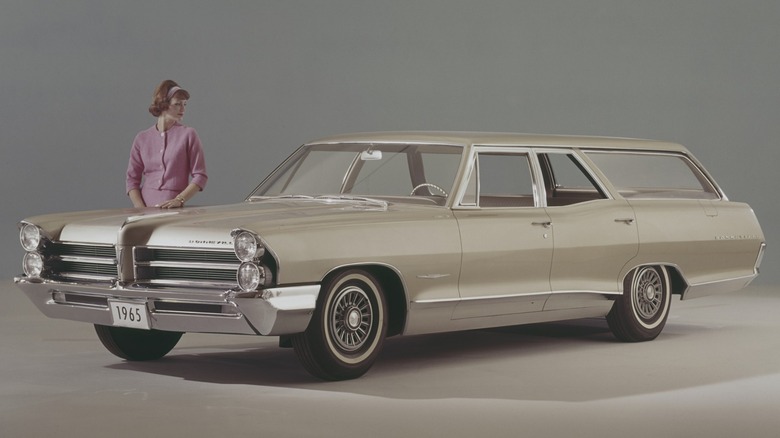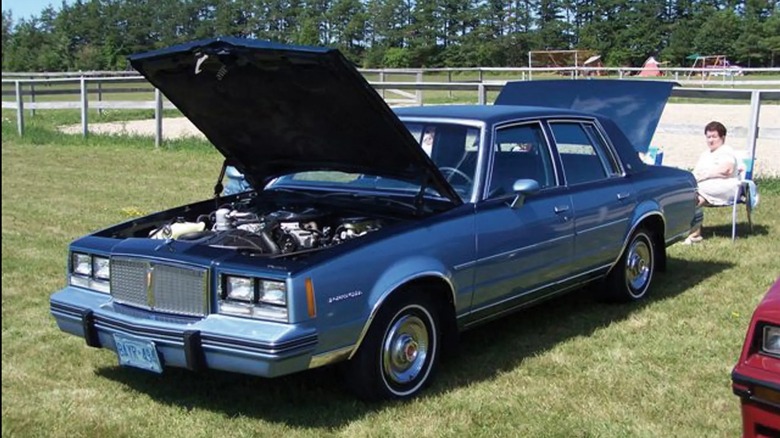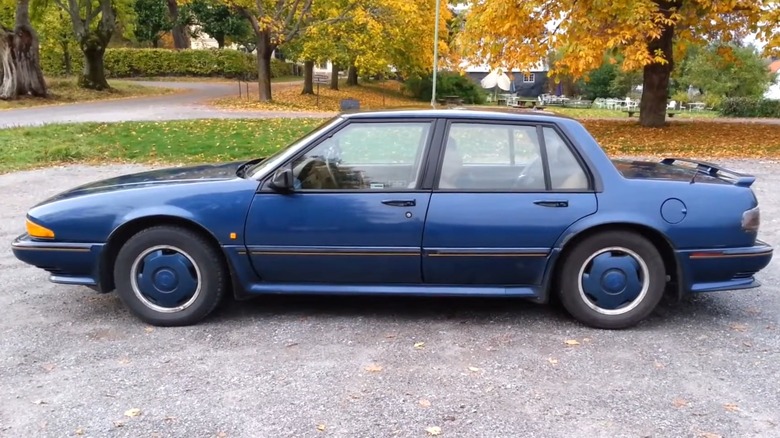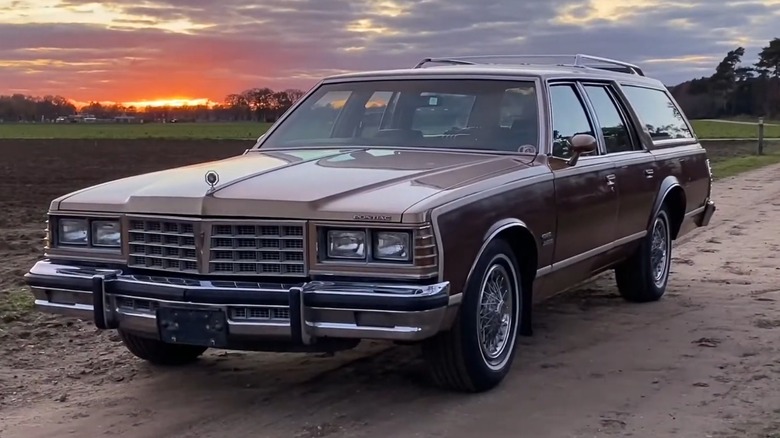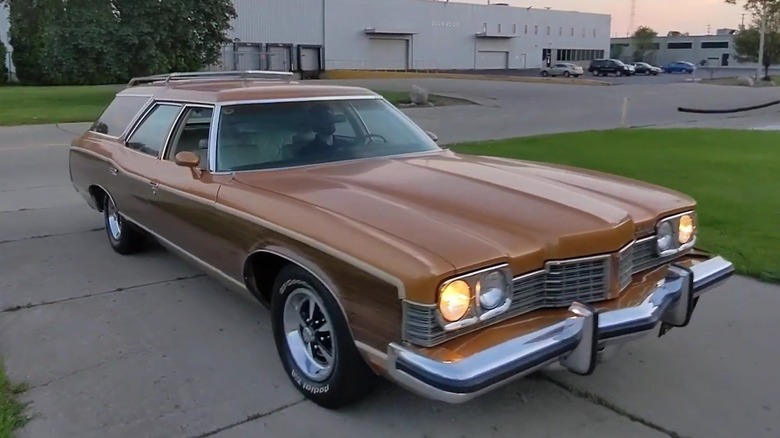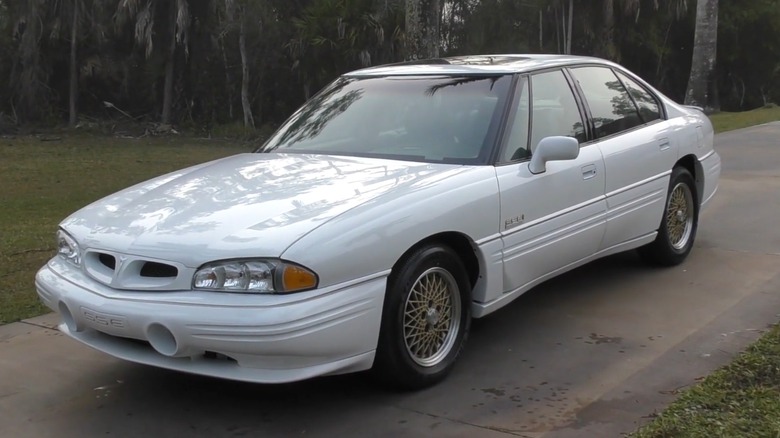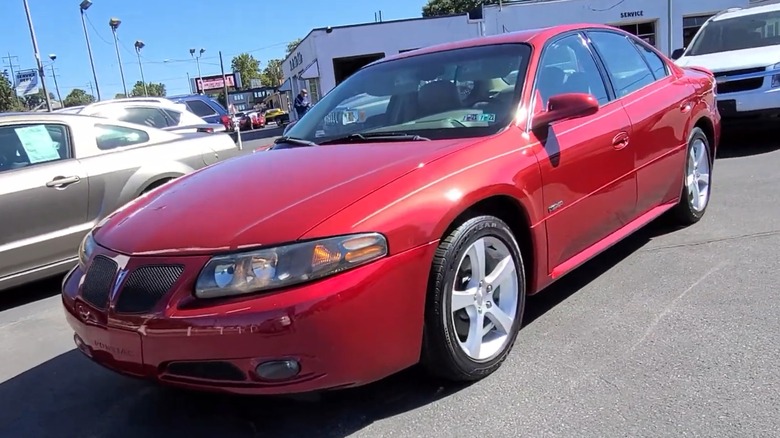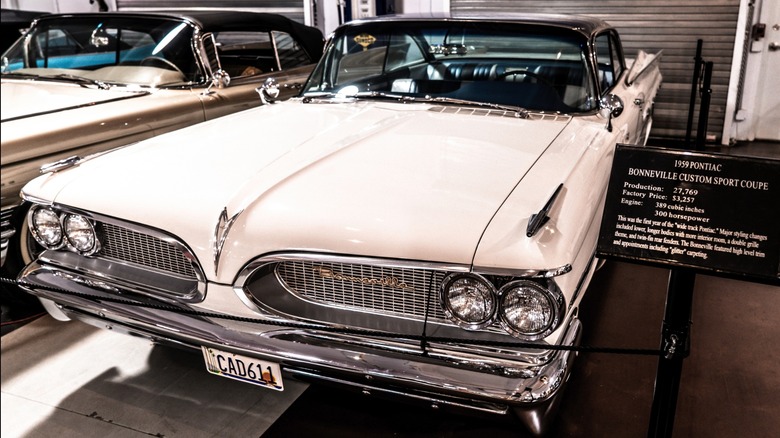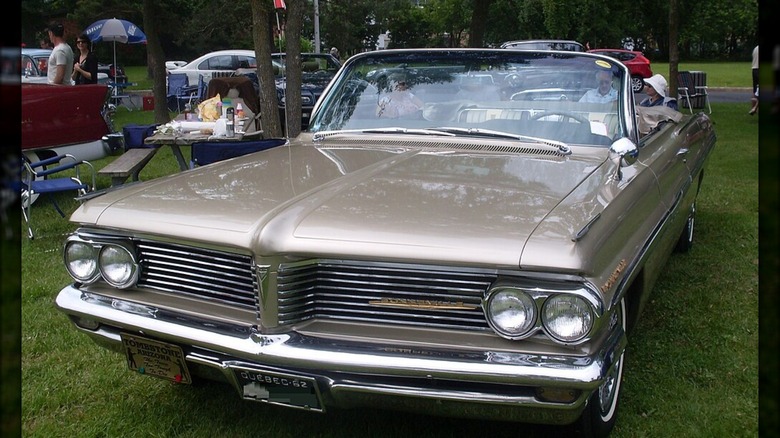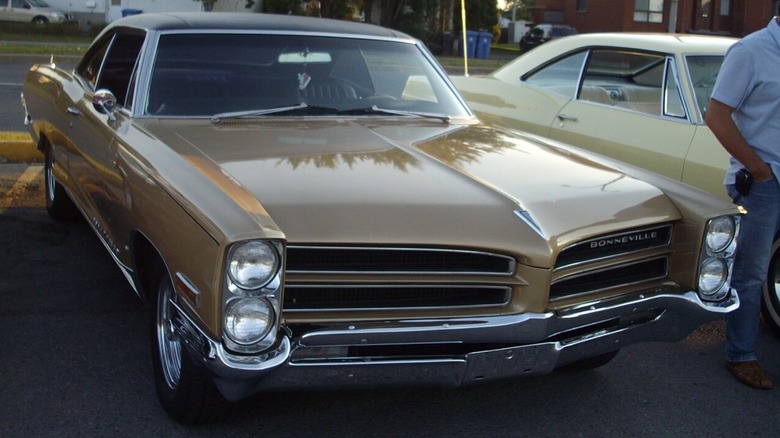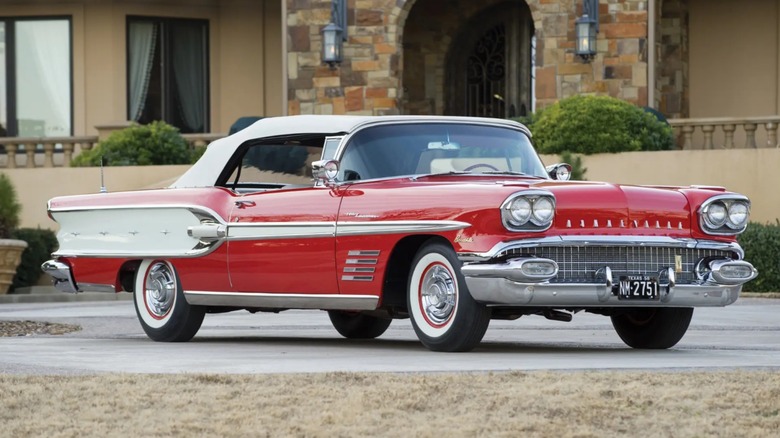Every Generation Of The Pontiac Bonneville, Ranked Worst To Best
The Pontiac Motor Division of General Motors holds a rich history in the American automotive landscape, with scores of memorable models enjoyed by drivers from coast to coast and beyond. Shortly after its creation, the brand was positioned with pricing above the top tier Chevrolet and below the lowest Oldsmobile. As an upscale bargain, Pontiac's cars offered unique features on familiar platforms, and its Bonneville sedan offered affordable style and comfort for nearly five decades.
In 1956 Pontiac hired David Abbott Jenkins, a man breaking speed records for fun, to take one of its cars to a place he promoted for inclusion in international auto racing. He broke 28 racing records in a Pontiac, leading the company to name a car after the place where it happened, the Bonneville Salt Flats. The 1957 Starliner Bonneville was a limited edition of which only 630 were made, but the next year, Pontiac introduced the new 1958 Bonneville. The Bonneville was one of the longest-running nameplates in automotive history, lasting until 2005 — just four years before GM announced the closure of the entire Pontiac division.
In all there were 10 generations of Pontiac Bonneville. The design and technology changed much over those years, making it difficult to fairly compare one to another. Therefore, based solely on looks, here is a ranking of 10 generations of Bonneville beginning with the most disagreeably styled of all.
10. Seventh-generation Pontiac Bonneville (1982-1986)
The 1980s were not kind to all who experienced it. It started with a hostage crisis before becoming inundated with neon colors and parachute pants, and most tragic of all were the abysmally slow cars coming out of Detroit. While sleek and attractive, the 1980 Corvette only came with 190 hp, which is a travesty, and Detroit pushed out a lot of other blunders, such as the seventh-gen Bonneville in 1982.
Early '80s cars brought us smaller vehicles sensitive to the overzealous fuel consumption of the prior generation. Full-size cars became mid-size and V8s were swapped for V6s. The Bonneville received a smaller chassis and a V6, although a V8 was still on offer for a time. It is hard to say what the designers were going for, but it appears they were told to target mediocre dentists and high school principals as potential buyers. They took the three-box car design a bit too literally, adorning it with some superficial chrome plating, faux wood paneling, and enough velour for a trio of bad suits.
As bad as this thing looked, its sins run deeper. For reasons unknown to God and man, the rear windows in the car were fixed. They did not open at all, leaving passengers sweltering when poor quality control — a hallmark of the era — inevitably kicked in and killed the air conditioning. It's so bad that back in 2007, Sotheby's auctioned one in mint condition, and it ended without a sale.
9. Eighth-generation Pontiac Bonneville (1987-1991)
When Pontiac went to completely redesign its Bonneville and move its styling into the modern age, it also brought a change that nobody was clamoring for, front-wheel drive. The new car flipped its engine sideways, dropped the V8 option, and entered the era of Bonnevilles fit for schoolteachers and bank tellers.
On a more positive note, the styling of this car received some much needed European flair and the 3.8-liter V6 received electronic fuel injection. A bit of the power lost in the '70s returned, but I can say as someone who has driven several of these cars, the handling was vague and uninspiring.
The eighth generation could have been a candidate for the bottom of the list except for the sporty and nearly desirable Bonneville SSE. Even though at the time Motorweek compared the design to a toaster oven, the SSE had some appeal. It shed the gaudy chrome and received a body kit with a spoiler, for a Euro sports sedan appearance. Its power remained lackluster, but at least it had the legendarily robust Buick 3800 V6 engine. Handling also improved on this more expensive version of the Bonneville, although the interior was still standard '80s GM. The bottom line is that for anyone wanting one of these Bonnevilles, the SSE was the only worthwhile option.
8. Sixth-generation Pontiac Bonneville (1977-1981)
As the Bonneville prepared for the end of the Carter administration, its styling moved into more reserved and understated territory — the designers seemed to have learned that rulers exist and they are good for making straight lines and right angles. This Bonneville had lines and angles aplenty, as is apparent from its rectangular quad headlights and dash panel full of rectangular gauges. Furthermore, horizontal lines across the grill match the faux chrome lines on the tail lights.
Despite its reserved styling, when pitting it against a contemporary like Mercedes-Benz 300D, it is easy to see why the German car was the superior choice. However, this Bonneville had two very good things going for it. First, these cars were large and extremely comfortable with giant plush bench seats. Second, it was also available as the Pontiac Bonneville Safari Wagon, the epitome of uncool cars that are somehow cool today.
With the Safari Wagon, you got seating for at least a dozen, including two or more in a rear-facing seat in the cargo area, perfect for a front-seat view of any rear-end collision. Plus, acres of fake trees had to not be cut down to adorn the very long car with glistening wood paneling from bumper to bumper in a glorious 1970's soccer mom smoking a Carlton with the kids in the car kind of way. It is glorious.
7. Fifth-generation Pontiac Bonneville (1971-1976)
The early '70s saw a time of great change for the auto industry. Just as the muscle car era hit its apex, new EPA regulations came in to sour the mood. Ironically, with emissions regulations meant to clean up the industry's tailpipe output, automakers simultaneously grew cars to the largest they had ever been. Cadillac's Fleetwood Series Seventy-Five expanded to a gargantuan 21 feet in length, and the fifth-generation Bonneville clocked in at nearly 19 feet.
For its debut year, this generation of Bonneville arrived sporting a bird's beak grille flanked by horizontal quad headlights. In its second year, the grille became less pronounced, and the round headlights were swapped for rectangular versions in '75. Its styling featured graceful and flowing curves from front to back with elegant creases in the hood to break up the massive slab of sheet metal in front of the driver. It was available in sedan, coupe, wagon, or in its best packaging, convertible.
These Bonnevilles were large-but-graceful machines ready to take the whole extended family to the drive-in diner. They offered upscale comfort with a stylish exterior and marked the end of an era of analog car design in American auto manufacturing. The following years were marked with repeated downsizing and increased technological innovations and digital design throughout the car. Today, they are inefficient and wholly impractical, but they make great lowriders, and that makes them hard not to love.
6. Ninth-generation Pontiac Bonneville (1992-1999)
Ranking the Bonneville of the bulk of the '90s this high on the list might be a bit controversial. However, with more grown-up technology and tighter handling, the '90s Bonneville was capable of hugging corners and delivering on Pontiac's claim that "We Build Excitement!"
The exterior of the updated Bonneville marked a clear improvement over the outgoing model. Its curvier body panels made for a pleasing overall shape, although the plastic body cladding could be considered excessive and possibly even cheap to some. Nonetheless, it still differentiated itself from other GM models and the competition. And if the base models still seemed a bit bland, Pontiac offered the supercharged SSEi for buyers considering something like an Audi or Saab at the time.
With even more stylized body cladding, a rear spoiler, custom wheels and grille, plush leather bucket seats, and best of all, the Pontiac Bonneville SSEi came with a supercharged 3800 V6. With up to 240 hp by the late '90s and its four-speed automatic, the SSEi was a true sports sedan. They are an often overlooked classic now and can be picked up for a reasonable price, such as one that sold on Bring a Trailer recently for $6,200. Compared to similar performance-oriented European and Japanese sedans of the era, that is a bargain.
5. 10th-generation Pontiac Bonneville (2000-2005)
Even before the last Pontiac ever built left the factory, Bonneville production had ended. Its final run took place from 2000 to 2005, leaving us with a handful of attractive and modern cars. The first year for this generation adapted much of the styling of the previous generation on a completely new body, retaining some of the more superfluous cladding and highly stylized front bumper. However, by the end of the run, designers smoothed out its lines and tidied up some of the more extravagant flourishes, leaving us with a handsome sedan that could go up properly against its counterparts from Europe.
While the final Bonnevilles were sleek and sporty sedans, the true Bonneville swan song graced dealerships only for the final year model. For 2005, Pontiac finally returned with a V8 in the Pontiac Bonneville GXP, powered by a transversely-mounted 4.6-liter DOHC Northstar V8. With 275 hp on tap courtesy of Cadillac, the final Bonneville performed appropriately to keep up with the best of its contemporary sports sedans.
Those who like the idea of having a "modern classic" can get a GXP for a relative bargain these days, with low mileage examples selling for just over $10,000, such as one recently sold on Bring a Trailer. However, even with their updated styling and excellent power output, you would still have to live with early 2000's GM plastics in the interior, which can look and feel a bit cheap. Still, it's not a bad way to go out.
4. Second-generation Pontiac Bonneville (1959-1960)
Across the decades of Bonneville production, the early years populate the most attractive of all of them. As it entered the 1960s, the Bonneville also entered a new era of Pontiac design and engineering innovation. Discontent playing second fiddle to the popular models from Chevrolet, Pontiac set out to assert itself with new models, including the all-new "Wide-Track" Bonneville.
While the wheels of the Bonneville had been moved further out for better handling and appearance, the nomenclature in advertising was largely marketing gobbledygook. Regardless, it worked and Pontiac's surge toward the top commenced. This second iteration of the Bonneville only lasted two years, but it helped to establish it as a sales leader and an attractive option for buyers of large cars who did not want to settle on basic transportation and who appreciated the power of a Pontiac 389 V8 engine.
With a more squared-off footprint, slick split grille, and subdued rear tail fins, the second-gen Bonneville came with a nice blend of '50s and '60s styling cues. Things changed even more the second year as the split grille went away and the more dynamic '50s flourishes went away as the tail fins were deleted and clean and straight lines adorn the sides and top of the car. A couple of 1960 highlights are the wraparound windshield and curved back glass along with the extraordinarily long and flat trunk, especially on the hardtop coupes. Both year model cars make for excellent hot rods for stunning appearances at any classic car show.
3. Third-generation Pontiac Bonneville (1961-1964)
Having proven itself through its first three years of sales, the Bonneville's place within Pontiac was firmly set. If you wanted a Pontiac available with all the bells and whistles in the largest and most luxurious package, the Bonneville was it.
After a single-year hiatus, the split grille was back on the Bonneville for 1961. The revised rang-topping Pontiac came with a squared off and sleek look with crisp clean lines front to back. Buyers chose between several body styles, and again, the best-looking pick of them was the drop top. A range of engine choices were offered but the best one had to be the tri-power 389 V8 with a trio of Rochester carburetors and 348 hp.
As the years progressed, so did the updates to the cars. While the first two years saw attractive and stylish models, 1963 brought the first Bonneville with stacked headlights, providing a more aggressive look that made it fit in with the increasingly competitive muscle cars of the day, even though it was officially a full-size car. By 1964, engine options had grown such that buyer's opting for the most power could have a 421 tri-Power V8 producing 370 hp and a very healthy 460 lb-ft of torque.
2. Fourth-generation Pontiac Bonneville (1965-1970)
While the Bonnevilles of the '70s were huge cars by all accounts, that trend began with the 1965 redesign of the model. Stacked headlights and clean lines remained while its width and breadth grew to a great degree. Nonetheless, its size did nothing to detract from its appearance as any Bonneville from 1965 through 1970 makes for a comfortable and stylish weekend cruiser as much today as it did back then.
The Safari Wagon option was originally added in 1963 and carried over into the 1965 model year, offering buyers the passenger and cargo capacity akin to a modern Escalade or Suburban thanks to acres of sheet metal going into the bodywork. The split grille was swapped in 1968 as the Pontiac "beak" had been incorporated throughout the lineup. Also that year, the Bonneville for the first time gained a sedan in addition to the four-door hardtop.
Of this generation of Bonneville, the first few years with the stacked headlights are the most attractive. The loss of the split grille and stacked headlights marked the end of an era as the Bonneville continued its journey into the enormous cruiser it became in the '70s. The 1970 model is still a grand and desirable car, but there is a version of it more rare than any other. In 1970, Pontiac sold 75,348 Bonnevilles and just 28 of them came with a manual transmission.
1. First-generation Pontiac Bonneville (1958)
While American car styling of the '50s was not known for being particularly sedate, the inaugural Bonneville leaned heavily toward the more flamboyant. Furthermore, while Chevrolet held the attention of the car-buying public with models like the Bel Air, Pontiac sought to differentiate itself with this and other models, moving away from being a companion brand and into one known for originality and style. The Bonneville delivered on this.
Engine options for 1958 included a base V8 offering a respectable 255 hp while Pontiac provided ample choices for more power. For example, buyers could get a tri-power option with three Carter two-barrels or go for the gold with the all-new Rochester fuel injection with performance camshaft and 10.5:1 compression for 310 hp, 10 more than the tri-power. Furthermore, a special PM package approved by NASCAR for competition raised the injected version horsepower to 330. Estimates of fuel-injected cars produced is around 200.
Styling was fueled by the space age and included an abundance of chrome and stylistic flourishes, such as the rocket-shaped trim running the length of the car. The gleaming chrome continues inside throughout, including on the Trans-Portable radio, which pulled out of the car to use at the beach, for example. But more than anything, this classic Pontiac was a beautiful car that kicked off a legendary car line. But being produced only one year has led to skyrocketing value exemplified in auctions such as one by Sotheby's in 2016 for $121,000.
